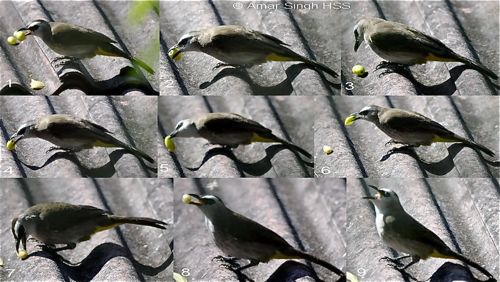“I have been watching birds feed on the Neem Tree (Azadirachta indica) in our garden for more than 10 years and recognise that it is an important food source for garden birds. It is also a useful “fruit tree” to attract birds to the garden. The Neem tree has a fruit that is oval, approximately 1×1.5 cm in size and has a skin covering, a thin pulp and a hard seed.
“Birds that feed on the Neem fruit in our garden include:
1. Yellow-vented Bulbul (Pycnonotus goiavier analis)
2. Black-naped Oriole (Oriolus chinensis)
3. Common Myna (Acridotheres tristis)
4. Asian Glossy Starling (Aplonis panayensis strigata)
5. Pink-necked Green Pigeon (Treron vernans)
6. Lineated Barbet (Megalaima lineata hodgsoni)
7. Common Asian Koel (Eudynamys scolopacea)
“Of these the Yellow-vented Bulbuls are the commonest. It also feeds the fruit to its young. It has been hard to capture this because the Yellow-vented Bulbuls, after plucking the ripe fruit, take it to our roof to ‘process’. They are very friendly birds but not excited for me to take photographs, while they are feeding on the roof, with me nearby with a large black object in hand (camera). I have observed the behaviour often with the naked eye.
“The above composite shows a sequence of feeding (numbered). Was fortunate to already be on the roof (noon day) and this was on the neighbour’s roof taken through lots of foliage, hence occasionally a bit blur:
#1 – After plucking, the Neen fruit is brought to the roof.
#2-4 – The fruit is positioned many times, put on the roof for readjustment (in this occasion
3 times), so that the bird can squeeze the closed end of the fruit.
#5-6 – Finally the ripe pulp and seed are ejected from (squeezed out from) the skin
covering the fruit.
#7-9 – The bulbul then swallows the pulp together with the seed whole.
“At peak fruiting we see large numbers of these empty shells on our roof or patio floor daily.
“All the birds listed above swallow the pulp and seed whole without the skin but most can do it while still in the tree. What puzzles me is that the volume of flesh (pulp) is small compared to the large seed, thus many fruits need to be eaten.
“Of course we have many Neem tree seedlings growing in our neighborhood as the Yellow-vented Bulbuls and others help propagate this tree.”
Dato’ Dr Amar-Singh HSS
Ipoh, Perak, Malaysia
17th October 2009
Note: The neem, also known as margosa tree, has been used in ayurvedic medicine since ancient times. In fact the Indians consider the tree a pharmacy in its own right. Every part of the plant has its use, from treating malaria, sores, boils, wounds, hemorrhoids to expelling intestinal worms and protecting the hair from lice. The twigs are used as a toothbrush and to prevent gum infection. In ancient times libraries in India used the leaves to keep books free from mites and other insects. Hindu devotees in Singapore and ?Malaysia carry a bunch of leaves together with two lemons as they walk across a pile of glowing lumps of coal during the festival of Theemithi.










8 Responses
This is a great sequence of shots. Do the koels also remove the skins? I have seen them swallow whole fruits that are bigger than this and have thicker skins.
Hi,
I would like to have a sapling of your Neem plant. Any way to give me some of the seeds ? or cutting ?
Thanks,
Sebastian
Neem saplings can easily be bought in nurseries. I bought one from a vendor in a Housing Board area some years ago and it is growing fine.
Hi,
As an aside, I still use neem leaves in my books! However, they need to be replaced after some time, as neem (in unprocessed/unpreserved form: either leaves, oil, manure, etc.) tends to lose efficacy in heat or sunlight. Neem leaves are used in containers or jars of flour, pulses, etc. to prevent insect attack. I also use neem as both organic fertilizer and pesticide. In India, where I live, I have observed animals such as rhesus macaque and langur eating the leaves and seeds – more for the medicinal properties, I suspect, than as a food source.
I agree about the medicinal properties of the Neem tree, leaves & fruit. It is well known and many neighbours will ask me for leaves. I have great respect in birds and their ability to identify useful foods, plants. The volume of flesh (pulp) is small compared to the large seed. The seeds are passed clean and can be often seen in our garden or on the roof. Do the birds like the fruit because it has a sweet pulp? Or rather because it has medicinal value which the birds know at an innate level? There has been data supporting the Azadirachtin founding Neem fruits kills bacteria and other parasites See: Tipu, M. A., Pasha, T. N., Ali, Z. (2002). Comparative Efficacy of Salinomycin Sodium and Neem Fruit (Azadirachta Indica) as Feed Additive Anticoccidials in Broilers. International Journal of Poultry Science. 2002, Volume 1 (4), Pg 91-93.
I collect the seeds around the tree base which germinate easily. Somehow the birds don’t eat the shells (though soft) perhaps of aftertaste? The seeds are said to contain the active insecticidal agent.